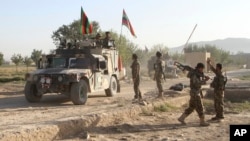Afghanistan's security forces, in joint counterterrorism raids with U.S. partners, this week have killed several high-profile leaders of al-Qaida, along with 80 other members of the terrorist network and the Taliban insurgency,
The Afghan intelligence agency, National Directorate of Security (NDS), announced details of the operations Tuesday, saying Omar bin Khetab, also known as Omar Mansoor, was among the dead.
Khetab was the second-in-command of al-Qaida in Afghanistan and the Indian subcontinent.He also was the most senior member of al-Qaida to have been killed in the country since 2001 when a U.S.-led invasion ousted the Taliban from power in Kabul for sheltering the leadership of the international terrorist group.
The joint security operations focused on the provinces of Ghazni, Zabul and Paktia, bordering Pakistan.They also destroyed five al-Qaida bases and arrested 27 militants, the NDS said.The agency did not give further details about the nationalities of Khetab and other high-profile slain commanders.
In a separate statement, the U.S. military confirmed the death of Khetab in operations it said were conducted on Monday.
The Taliban has rejected the claims as baseless, saying the Islamist insurgency has no links with any foreign organization.In a statement sent to media, the group's main spokesman, Zabihullah Mujahid, also denied any Afghan-U.S. operations this week in the three provinces.
The U.S. military in its statement also confirmed the killing of a top Taliban commander in a separate kinetic strike conducted in southern Helmand province. The Afghan spy agency announced earlier this week the death in a security operation of Mullah Shah Wali, also known as Haji Nasir, who commanded the so-called "Red Unit" elite force of the Taliban in the largest Afghan province.
Nasir and his "Red Unit" are responsible for planning numerous suicide bombings, IED attacks and coordinated assaults against civilians, Afghan and coalition forces," stated the U.S. military.
The commander of U.S. troops and NATO's Resolute Support mission in Afghanistan, General John Nicholson, praised the operations as a "testament to the real growth" Afghan forces have achieved over the past year.
"It is also another example of the lethality of the undefeated Afghan Special Forces and the success of working side by side with our Afghan partners."
Borhan Osman, a senior analyst at International Crisis Group for Afghanistan, described Nasir's death as a major loss for the Taliban insurgency. Osman wrote on his official Twitter account that the slain insurgent commander led decisive Taliban battles in northern Helmand and fought militants of the Afghan branch of rival Islamic State.
Tactical collaboration
Last week, General Nicholson spoke in detail about the presence ofal-Qaida remnants and its affiliates and their ongoing collaboration with the Taliban.
Even though the Taliban would not publicly acknowledge ties with al-Qaida, there is still a close relationship at the "tactical level" between the two, the general noted.
"They [al-Qaida] tend to provide some of the expertise, the training on specialized weapons or IEDs or bomb making. It is al-Qaida in the Indian subcontinent fighters who are the ones who are training a lot of local Taliban, and in return for this, the Taliban affords them sanctuary," Nicholson said.
Nicholson also said U.S. forces continue to hunt al-Qaida fighters and strike them wherever they find them, primarily in the eastern part of Afghanistan.
"And when you find them, they are existing within a friendly environment created by the Taliban," Nicholson said.
U.S. forces two years ago located and destroyed a major al-Qaida camp in the southern Afghan province of Kandahar, killing a large number of militants.
The United States and its allies invaded Afghanistan 16 years ago to bring al-Qaida leader Osama bin Laden and his associates to justice, accusing them of masterminding the terrorist attacks on U.S. cities on September 11, 2001.
The U.S. military has since killed a large number of commanders and fighters of the group in Afghanistan. Bin Laden was located and killed by U.S. special forces in 2011 in a covert raid against his hideout in neighboring Pakistan.








